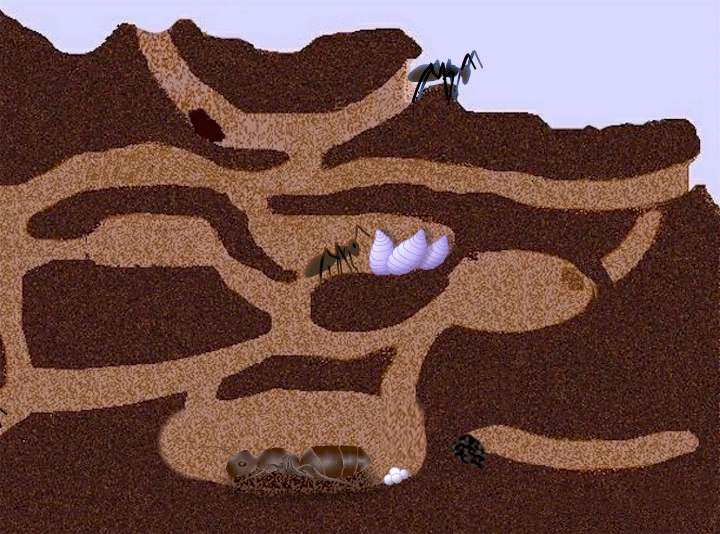|
Ants |
|
|
|
|
|
|
| A Typical Ant Nest | ||
|
Worker
ant scouts returning to nest |
 |
Worker ant digging |
|
Ant Larvae look
like grubs. They are shown in the center of this ant colony. A worker ant is feeding the larvae. |
||
| Egg laying Queen | ||
The ant larvae hatch from the ant eggs.
|
|
The typical ant colony is usually centered around one or more egg-laying "queens". If there is only one queen, it is the mother of all the ants in the colony. The smaller worker ants care for the queen, and the young ants in other stages of development. |
| Queen Ant |
|
Male ants are usually smaller than the queen. They both have wings. The male's life-span is short. Only the queen begins a new colony. |
|
|
A typical queen ant will usually fly to a new location to start a new colony by herself. She will not need to fly anymore, so she sheds her wings. |
|
Ant Power |
With their combined weight greater than the combined weight of all humans, ants are the most numerous type of animal. |
|
Strong in relation to their size, ants can carry 10 to 20 times their body weight. They work in teams to move extremely heavy things. |
|
Ant brains are largest amongst insects. Mushroom shaped brain appendages have function similar to the gray-matter of human brains. |
|
It has been estimated that an ant's brain may have the same processing power as a Macintosh II computer. |
|
Ant Work |
|
What happens when ants are painted with color dots? |
|
Colored dots painted on the backs of ants according to the type of work they are observed doing show that ants have specific jobs. |
|
|
|
So yellow dotted ants would concentrate on cleaning. Teams of green dotted ants forage outward for food. Orange dotted ants would take care of the young. |
|
|
| After a few days or weeks, the ants may change their jobs as they take on new skills. |
|
Sometimes when a catastrophe occurs, the ants respond by quickly adapting their duties to overcome the problem. |
| Ant Society |
ANTS DISPLAY THESE SOCIAL ENDEAVORS* |
LIVESTOCK FARMING |
| herd aphids and "milk" them for nectar-like food |
CULTIVATION |
growing underground gardens for food |
| CHILDCARE |
| feeding young and providing intensive nursery care |
| EDUCATION |
| teaching younger ants the tricks of the trade |
| CLIMATE CONTROL |
| maintaining a strict 77o F or 25o C. for developing ants |
| CAREER SPECIALIZATION |
| changing & learning new careers |
| CIVIC DUTIES |
| responding with massive group projects |
| ARMED FORCES |
| raising an army of specialized soldier ants |
| SECURITY |
| warding off other ants, insects and animals |
| EARTH MOVERS |
move at least as much soil as earthworms |
| SOCIAL PLANNING |
| distribute different jobs among the colony |
| ENGINEERING |
| tunnel from two directions and meet exactly midway |
| COMMUNICATIONS |
complex tactile (touch) and chemical communication system (smell) |
| FLOOD CONTROL |
|
incorporate water traps to keep out rain |
| TRIAGE |
| provide care for their injured that are most likely to survive |
| SANITATION |
| some ants process waste material so that it safely decomposes |
|
LIMITED FREE WILL
|
| * Many of these activities have been observed among specific species of ants. Not every activity listed is found in all species. |
|
|
All images, animation and ant tunnel background on this website were created by Robert Truscio.
Educational and school websites may link
to this page.
©1997-2016 Robert Truscio (revised 2024)
(Surfnetkids & Bigchalk logos used by permission)
|
This site was found to be in the top 2% of sites reviewed by bigchalk.com based on its rich content and its academic relevance. |